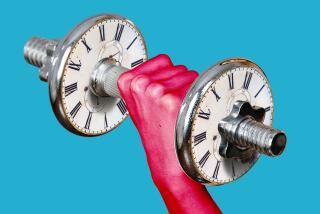Good Warmups Can Keep Older Golfers in the Game
- Share via
Sixty-year-old Jack Nicklaus will be back on the pro golf tour this season, just months after his January hip replacement. Gary McCord, a 25-year Professional Golfers’ Assn. veteran and golfing instructor, still plays on the Senior PGA tour and has no plans to stop any time soon.
Retired golf great Arnold Palmer, 69, plays nine every day.
Like millions of senior hackers, these golf legends have discovered that golf can be played throughout the golden years--if you avoid injury and stay in shape. The American Physical Therapy Assn. says older golfers can forget that while enthusiasm remains high, their bodies have aged.
“People lose flexibility, muscle mass and strength as they age, and that’s where problems start,” says Bill Hardy, a physical therapist at Valley Physical Therapy and Sports Medicine Services in Middletown, Conn. “Since the golf swing involves an extreme amount of bending and twisting of the spine, as well as rotation of the hips and shoulders, senior golfers are at a greater risk of injury.”
New designs in golf equipment can help compensate for stiffness, lack of flexibility and other physical limitations older players may have. Shafts made of graphite and other materials help increase swing speed and power without any change in strength. Clubs with oversized heads offer a larger, more effective hitting area. Oversize grips provide shock-absorbing flexibility.
But while improved technology can lesson physical stress, proper body mechanics on the golf course play an even larger role in preventing injuries.
Bending the knees before swinging, rotating the hip and spine during the golf swing and using correct range-of-motion techniques throughout the swing all reduce strain on the body. Proper mechanics off the course, such as correctly lifting golf bags and equipment and ongoing physical conditioning, are just as important.
Hardy says many weekend or seasonal senior golfers put themselves at risk by trying to swing as hard as professional athletes, often after hibernating all winter or sitting behind a desk all week.
” Typical golf injuries include muscle strains and neck, spine and joint irritations. Industry statistics show that the typical golfer loses an average of 5.2 weeks of playing time annually because of injury.
Says Hardy: “The good news is that the effects of aging on your golf game can be addressed and even slowed if you just keep yourself in shape and practice good body mechanics.”
*
For a free set of injury prevention tips for senior golfers, send a self-addressed, stamped envelope to “For the Young at Heart,” American Physical Therapy Assn., Box 37257, Washington, D.C. 20013.
More to Read
Go beyond the scoreboard
Get the latest on L.A.'s teams in the daily Sports Report newsletter.
You may occasionally receive promotional content from the Los Angeles Times.










